UltraBattery™
There is an increasing demand for the use of hybrid/full-electric vehicles (vehicles powered by batteries and/or fuel cells) and renewable energy (mainly wind and solar energy) to save fuel and reduce emission of carbon dioxide. The electric energy storage/conversion devices are inevitable parts of these applications and hence their performance and cost (e.g. capital and running cost) are of great concern.
The UltraBattery®, developed by CSIRO Energy Technology in Australia under the leadership of Lan Lam, is a hybrid energy storage device which combines a supercapacitor and a lead-acid battery in a single unit cell, taking the best from both technologies without the need for extra expensive electronic controls. The supercapacitor enhances the power and lifespan of the lead-acid battery as it acts as a buffer during high-rate discharge and charge. Thus, the UltraBattery® in a hybrid electric vehicle is able to deliver and absorb charge rapidly during vehicle acceleration and regenerative braking, respectively. In wind turbine applications it can also absorb the noise generated by the variation in wind speed, delivering a smooth power output.
For both advanced automotive applications, and grid-connected wind energy applications, UltraBattery® has shown excellent performance and has the potential to remarkably improve the economic viability, and therefore the ‘uptake rate’ of HEVs and better utilisation of renewable energy. This, in turn, will reduce the global consumption of fossil fuels and the production of greenhouse gas emissions.
The UltraBattery® technology has been licensed to the Furukawa Battery Co., Ltd, Japan and the East Penn Manufacturing Co., Inc., USA. CSIRO and Cleantech Ventures have also invested in technology start-up Ecoult Pty Ltd to develop and commercialise battery-based storage solutions. Ecoult battery technology aims to deliver a low-cost, high-performance, high-power, stationary energy storage solution suitable for grid-connected and remote applications. UltraBattery® technology forms the basis for the Ecoult system.
Hybrid-electric vehicles and energy-storage systems
The storage of energy particularly electrical energy has gained greater importance than ever before, mainly due to the strong world-wide concern over global warming and the depletion of the fossil fuels. To tackle these issues effectively, there is an increasing demand for high performing rechargeable batteries to assist the development of zero-emissions vehicles (ZEVs) and the exploitation of renewable energy. The zero-emissions vehicles encompass electric vehicles and/or fuel-cell vehicles, which use alternative fuel, such as hydrogen, produced without greenhouse gas emissions. Since these vehicles are still under development and improvement, lower emission and lower fuel consumption, hybrid electric vehicles (HEVs) have been developed and commercialised for use during this transition phase.
At present, candidate energy storage systems for HEV applications include valve-regulated lead-acid (VRLA), nickel-metal hydride (NiMH), rechargeable lithium batteries, and supercapacitor. The VRLA battery has the great advantages in terms of low initial (capital) cost, well established manufacturing base, distribution networks and high recycling efficiency (about 95%) compared to the other competitive technologies at their current stage of development. Nevertheless, the running cost of the VRLA battery is expensive because of the short service life. Under the HEV (e.g., high-rate partial state-of-charge cycling) applications, the VRLA battery fails prematurely due to the sulfation of the plates, particularly the negative plates. The negative plates suffer from a progressive build-up of ‘hard’ lead sulfate on the surface, i.e., lead sulfate which is difficult to recharge. The accumulation of lead sulfate markedly reduces the effective surface-area to such extent that the plate can no longer deliver and accept the power required by engine cranking, acceleration, and regenerative braking.
An approach to extending the life of the lead-acid battery is to connect the battery pack in parallel with a supercapacitor. It is well known that a supercapacitor can provide and receive high-power, but low energy and, therefore, for HEV applications, the best use of this technology is to absorb high-power from regenerative braking and to provide high-power for acceleration. This requires the energy and power flow between the capacitor and battery pack to be managed by an electronic controller. In principle, during vehicle braking and acceleration, the controller will first regulate the power to/from the supercapacitor, then to/from the battery pack. During engine charging and cruise driving, the controller will regulate the power and energy mainly to and from the battery pack. This system has been developed by CSIRO and has been used successfully in the Holden ECOmmodore and aXcessaustralia demonstration cars in the year 2000. Nevertheless, the drawbacks of this system are that it is complicated (e.g. requires a sophisticated algorithm) and is expensive.
Accordingly, CSIRO Energy Technology has developed an advanced UltraBattery® to replace the complex and high cost supercapacitor/lead-acid battery system.
Configuration of the UltraBattery®
The UltraBattery® is a hybrid energy-storage device, which combines a supercapacitor and a lead-acid battery in a unit cell, without extra, expensive, electronic control. The schematic configuration of the lead-acid cell, a supercapacitor and an UltraBattery® is shown in the figure below. A lead-acid cell comprises one lead-dioxide positive plate and one sponge lead negative plate. An asymmetric supercapacitor is formed when the lead negative plate of the lead-acid cell is replaced by a carbon-based negative plate (i.e. capacitor electrode). Since the positive plates in the lead-acid cell and the asymmetric supercapacitor have a common composition, they can be integrated into one unit cell by internally connecting the negative plates of the battery and the supercapacitor in parallel. Both these electrodes now share the same positive plate in the UltraBattery®.
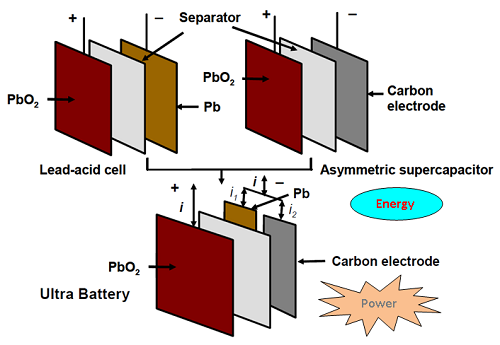
With this design, during discharge and charge, the total current of the combined negative plate is composed of two components, namely, the capacitor current and the lead-acid negative plate current. Accordingly, the capacitor electrode can now act as a buffer to share the discharge and charge currents with the lead-acid negative plate and thus prevent it being discharged and charged at the full rates required by the HEV duty. A second capacitor electrode can also be connected with the lead-acid positive plate in parallel. With such a configuration, the supercapacitor can share the discharge and charge currents with both positive and negative lead-acid plates and prevent the entire lead-acid battery being discharged and charged at the full rates.
The UltraBattery®, which can be produced as either flooded-electrolyte or valve-regulated designs in the existing lead-acid factory, can be reconfigured for a variety of applications, such as: conventional automobile,etc.
Even though the description of UltraBattery® configuration seems simple, it does not mean that the UltraBattery® can be easily achieved by just inserting any capacitor electrodes into a lead-acid battery. This is because there is a difference in the operational potential range between the capacitor electrode and the lead-acid negative plate. Thus, in order to make an operational UltraBattery®, significant effort has to be devoted to the modification of the capacitor electrode to achieve the following:
- similar working potential to that of the lead-acid negative plate
- low hydrogen gassing rate
- higher capacity to share the current with the lead-acid negative plate at least for 30 s
- long cycle-life
- sufficient mechanical strength and ability to produce in the existing lead-acid factory
- low cost.
In addition, the UltraBattery® should be redesigned so that it can accommodate the capacitor electrode without causing major increase in the battery weight.
The results from comparative tests in the CSIRO laboratories demonstrated that the UltraBattery® has greater discharge/charge power and significantly longer cycle life than that of the conventional lead-acid counterpart. By 2009 the UltraBattery® was at the preproduction stage and a small volume of batteries had been produced at the Furukawa Battery Co., Ltd, Japan and the East Penn Manufacturing Co., Inc., USA for field trials in HEVs and wind energy applications. Mass production of such batteries will be commenced from 2010.
Performance of the UltraBattery® under HEV Applications
The dimensions of the prototype UltraBattery® used in medium HEVs are shown below. According to the US FreedomCAR protocol, the discharge and charge power are 25 and 20 kW set for the minimum power-assist system and 40 and 35 kW set for the maximum power-assist system, respectively. Results reveal that the UltraBattery®, operating in an 80-30% state-of-charge (SoC) window, will meet or exceed the discharge and charge power required by the minimum and maximum power-assist systems. With the integration of the supercapacitor electrode, the operational range of the UltraBattery® is increased (between 80% and 30% SoC), instead of 70-30% SoC as usually used for the VRLA battery. The UltraBattery® technology has also met or exceeded the targets set for available energy, cold cranking and self discharge required by the minimum and maximum power-assist systems. Results show that the self-discharge of UltraBattery®, even under higher temperature, is still smaller than that specified in the US FreedomCAR protocol.
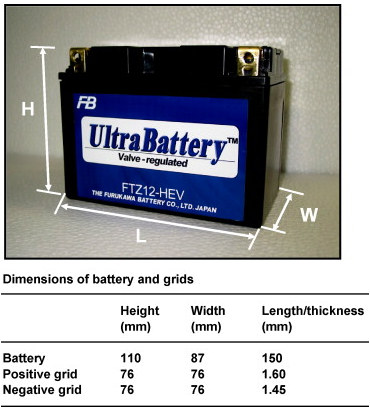
A prototype UltraBattery® shows significant longer cycling performance than the control VRLA battery. More importantly, the cycling performance of UltraBattery® is proven to be comparable, or superior, to that of NiMH cells where side-by-side testing has been conducted.
Twelve UltraBattery® have been subjected to field trial in a Honda Insight HEV at Millbrook, UK. and demonstrated very good acceptance of the charge from regenerative braking even at high state-of-charge, e.g., 70%. The HEV powered by UltraBattery® gives slightly higher fuel consumption (cf., 4.16 with 4.05 L/100 km) and CO2 emissions (cf., 98.8 with 96 g/km) compared with that by NiMH cells. There are no differences in driving experience between the Honda Insight powered by UltraBattery® and by NiMH cells. While demonstrating comparable performance, the UltraBattery® pack costs considerably less, only 20-40% to that of the NiMH pack by a rough estimate.
The Honda Insight HEV powered by the UltraBattery® pack has been displayed at the Geneva Motor Show on April 2008 and Yokohama on May 2008. After that, the vehicle was handed to Furukawa Company for continuation of the field trial. To date, the Honda Insight powered by the UltraBattery® pack has surpassed 140 000 miles and the battery pack is still in healthy condition.
Performance of the UltraBattery® under wind energy applications
An evaluation is in progress for the suitability of UltraBattery® technology for the storage of wind energy, particularly in grid-connected system.
The emission of CO2 from coal-fired power stations is a major contributor to global warming. The use of alternative energy sources ‘ such as solar, wind or hydro ‘ would mitigate this problem. The conversion of wind energy to electricity is currently 8-10 times less expensive than through the solar photovoltaic route. Nevertheless, the application of wind energy encounters three main issues, namely, variation in wind speed, intermittent wind energy (power only produced when the wind blows) and high-wind shutdown (the wind turbines are designed to shutdown in very high wind speed conditions). Thus, the main challenge for wind power is to overcome such issues and to get enough of it on the grid.
European countries have demonstrated the ability to get over the variability of wind ‘ western Denmark and northern Germany have 30 per cent wind power. The ultimate answer is to have a portfolio of solutions like Germany, which has set a target of 70% of its energy from renewables by 2050. There has also been an impressive growth in the uptake of wind energy in Australia. On current projections, Australia is set to have one of the highest contributions of wind energy into the power grid in the world.
To ensure that the rapid growth of wind power can continue, and therefore reduce Australia’s overall Green House Gas emissions, it is essential that a large quantity of wind energy be seamlessly interfaced into the national power grid. This does, however, present some network issues. For example, the variation of wind speed can add ‘noise’ to the grid, while the unpredictability of the wind and high-wind shutdown can destabilise supply to the grid network. One way of dealing with such variability and intermittence is to store energy generated during windy periods in onsite batteries, to provide a smoother supply to the power grid. Lead-acid batteries would be a cost-effective solution, but they are not sufficiently durable in terms of service life under highly fluctuating wind power applications. Rechargeable batteries ‘ nickel-metal hydride and lithium ‘ are just too costly.
The UltraBattery® might provide an effective means for the storage of wind energy. The battery cell would allow the unit to store a large amount of energy, whereas the capacitor component would serve to level the noisy wind variation without affecting performance. Furthermore, a combination of such technology with improved weather forecasting and smarter grid management would balance the peaks and troughs of wind-derived electricity at the point of generation and reduce the size of the energy-storage facility. For example, if a forecast indicates that the wind will reduce after a few hours, then the smarter grid management system will regulate more energy from the wind turbine to charge the battery pack to a higher SoC. Accordingly, the battery pack can provide energy to the grid in the subsequent no-wind period for a sufficient duration (about 15 to 30 minutes) to enable the start-up of an additional power station. With this operational design, the battery cost can be lowered substantially since the energy storage element constitutes a significant part of the cost of the whole system. The batteries in such a system may be operated under HRPSoC conditions.
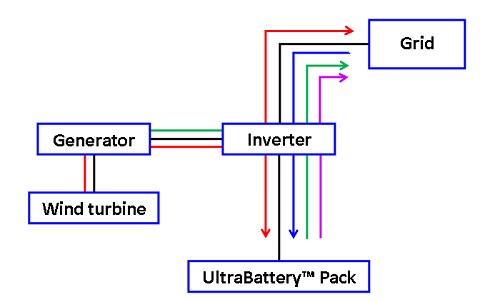
The following four scenarios demonstrate the comparability between the functionality of the grid-connected wind energy system and that of the plug-in HEV (as illustrated above):
- the wind turbine provides power directly to the grid as well as to the battery pack for charging, similar to the cruise driving mode of the HEV system
- the battery pack is charged by the power from the grid, similar to the regenerative braking mode in the HEV
- the battery pack and the wind turbine both provide power to the grid, similar to the acceleration mode of the HEV system
- the battery pack alone supplies power to the grid for short period during low wind or wind shut-down, similar to the pure-electric driving mode of the plug-in HEV in the urban environment.
Thus, the UltraBattery® technology developed for HEV application is expected to be useful for the wind energy storage systems. Accordingly, the UltraBattery® has been scaled-up to a size suitable for wind applications. A 2-V UltraBattery® together with a 2-V control battery have been evaluated under a simplified wind profile. This profile is the combination of a constant-current discharge/constant-current constant-voltage charge profile and the wind-variation profile. The cycle-life of the UltraBattery® was found to be about two to three times longer than that of the control counterpart. In 2009, field trials commenced at the laboratories of CSIRO Energy Technology, Newcastle, Australia. One wind turbine has been equipped with an UltraBattery® pack (as shown below) and a second with conventional VRLA batteries; each pack consists of forty-eight 2-V batteries.
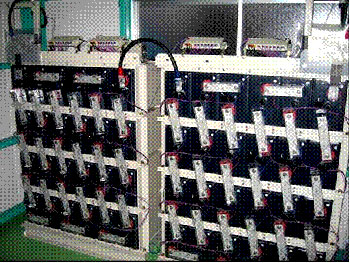
The connection of each battery to wind turbine is shown schematically in the figure below. Twelve 2-V batteries are connected in series (e.g., one string) to each phase of the wind turbine. Thus, one three-phase wind turbine requires three strings of batteries. At present, however, four strings of batteries have been connected, the additional string #4 allows the condition of individual batteries in a given string to be monitored after selected periods of service. For example, after three months, battery string #1 is replaced by string #4. The open-circuit voltage and internal resistance of each battery in string #1 is then measured in order to check the degree of balance between individual batteries.
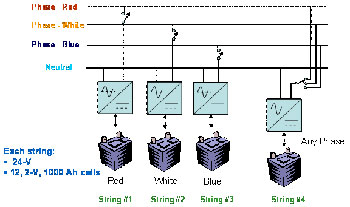
Impact and awards
The unique integration of the lead-acid battery and supercapacitor into a unified power source was first developed at CSIRO. In addition the patent application and technology transfer of the UltraBattery® system has been successful. The technology has been licensed to the Furukawa Battery Co., Ltd, Japan and to the East Penn Manufacturing Co., Inc., USA and is also under licensing negotiation with companies in Europe, China, India, South Africa and Australia.
The East Penn Manufacturing Company was granted an award of US$32.5 million to manufacture the UltraBattery® for micro-, mild- and medium-HEV applications. The grant is part of US$2.4 billion in funding for 48 advanced battery and electric-drive projects announced by US President Barak Obama on 5 August 2009 under the America Recovery and Reinvestment Act (ARRA).
A spin-off company, called Ecoult, has been established to market the UltraBattery® and battery management system for renewable-energy applications.
Lan Lam and the UltraBattery® group have been recognised by the following awards:
| 2009 | Technical Development Award of The Electrochemical Society of Japan |
| 2008 | CSIRO Medal for Research Achievement |
| 2005 | International Lead Medal presented by the International Lead-Zinc Organization at the 11th Asian Battery Conference, Ho Chi Minh City, Vietnam |
| 2000 | CSIRO Chairman’s Medal (Low emission vehicle team) |
Obviously, the success of the UltraBattery® will provide greater choices for the developers of HEVs and wind energy systems and the cost reduction of such energy-storage systems will further promote the wide spread use of both applications. This, in turn, will lead to reductions in the global consumption of the limited supplies of fossil fuels and thus reduce the production of greenhouse gas emissions.
Source
- Lam LT, 2009, Personal communication.
